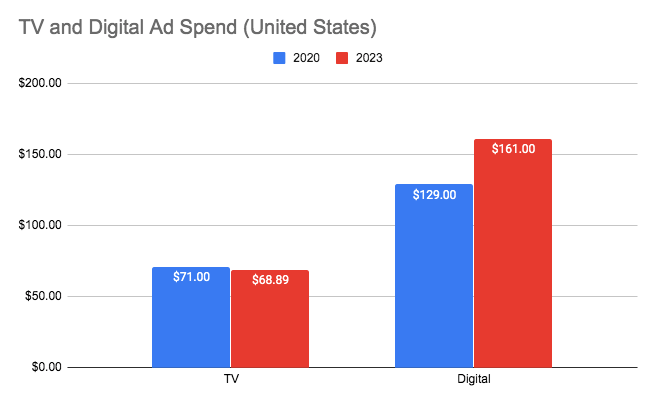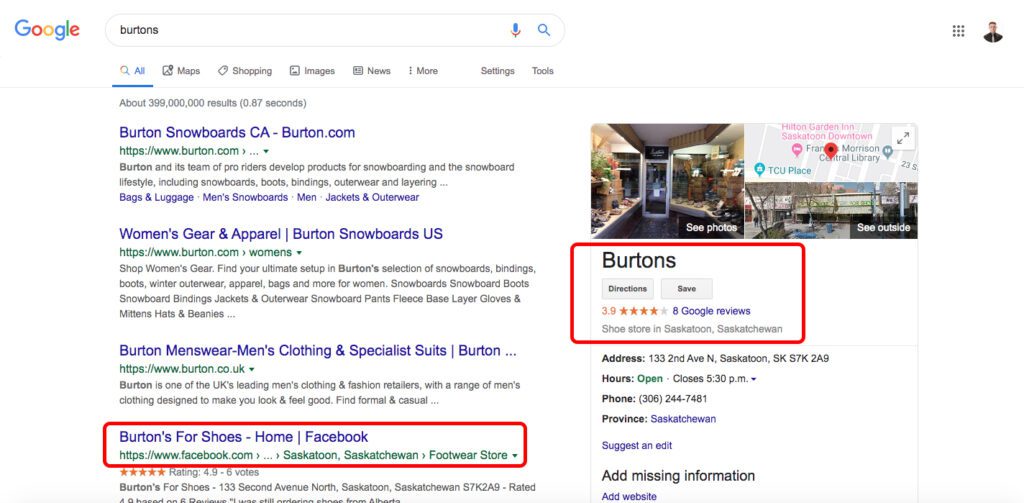For TV companies that are aiming to grow in 2020, there are a few options: out-market the competition, deploy programs to increase ad spend per account, or sell new solutions to capture new revenue. However, marketing is an expensive game to play, and upsell tactics take time. The fastest route to revenue in TV is through product diversification. Here’s why.
Why are TV Revenues Falling?
According to eMarketer, TV revenue is projected to decline by 2.2% per annum until 2023. This means that TV companies are going to be subjected to fierce competition as a means to simply maintain existing market share. Over the same period, digital media channels are projected to grow over $30 billion to a total expenditure of $161 billion by 2023.
Here’s how projected TV revenues stack up against the likes of digital over that same timespan:

eMarketer
This is making it harder than ever for TV companies to unlock new growth through traditional channels. Here’s where it went wrong.
The Over-the-Top (OTT) Revolution
Over the top channels (Netflix, Hulu, Amazon Prime, YouTube etc) didn’t steal ad dollars from TV companies, they did something far worse. They stole viewers. In turn, this user shift diluted the value of TV ads as reach began to decline.
Attribution & Segmentation
TV works, but the greatest challenge in TV advertising is mapping a clear path from ad to lead to sale. Another challenge is the segmentation limitations that accompany TV as a medium. Although you are able to target lifestyle and psychographic markets through ad placements (based on time, channel, program, etc), certain demographic variables are simply out of reach. Consider LinkedIn where you are able to target people by job title, industry of employment, or even by name. The depth of segmentation available in digital is rarely matched.
Multi-channel Marketing
Most TV advertising clients are not exclusively relying on TV to meet their marketing needs. Most of your clients are using a combination of TV, traditional, digital, and otherwise. This means that less revenue ends up going to each of these individual channels, UNLESS you are a provider that can offer multiple marketing solutions to span these channels. This is both a challenge and an opportunity for TV companies that are willing to diversify their solution sets.
Digital is Mandatory
Ninety-seven percent of US adults under 65 are on social media at least once a month, with the majority checking in daily. These same people are averaging 2.2 hours per day on social media. Businesses cannot ignore these trends, and that’s why we are witnessing rapid growth in the digital advertising market.
Here are the stats:
- Digital ad spend in the US is projected to grow to $161B by 2023.
- Many industries (such as auto dealers) are now mandated to spend 50%+ of ad budget on digital channels.
- Selling a client a single advertising solution proves a retention rate of 30% over 2 years. Selling that same client 4 solutions proves a retention rate of 80% over the same timespan.
- Your audience is online. According to the global web index, digital consumers are now spending 6 ¾ hours a day online, with 51% of that time spent via mobile device, and 2.2 of those hours being spent on social media alone.
By adding digital ad offerings to TV, you can provide your clientele with a value add that no marketing agency can, and differentiate yourself from other TV competitors.
5 Digital Solutions for TV
Adding digital solutions to a TV portfolio shouldn’t be done without proper due diligence. Choosing the right solutions to align with TV ads and minimize both internal and external education will be critical.
Here are the top 4 solutions for TV companies that are ready to take the first step towards new digital revenue.
1. Digital Advertising
This is the bread and butter for most TV companies because it’s the first thing your local clients look for when it comes to digital. Therefore, offering digital advertising technology and services can be a great way to start the digital conversation. However, this can be one of the steepest learning curves for TV companies looking to fulfill with existing in-house resources.
Some of the alternative options include:
- Hiring digital ad specialists
- Outsourcing fulfilment to a 3rd party
- Working with a white-label digital advertising partner
2. Listings
TV advertising generates awareness for your clients. That awareness is likely to manifest itself in the next step of the consumer journey: research, generally conducted through a Google search (or other directory search).
But what if your clients don’t have accurate listing data shown? What if that prospect clicks on the phone to make a call, but the phone number isn’t up-to-date?
I’ll tell you what happens:
- That prospect is going to select the next search result on the list
- The prospect is going to choose them if their data is correct
- The prospect will have lost trust in your client’s brand
- Your client’s TV ad spend just payed for a lead for their nearest competitor
Now, if it were just Google, then your prospects would be able to manage their own data, but the reality is that there are 100+ apps and directories that will be listing most of your clients. This volume of data is almost impossible to manage without some technological assistance. Ergo, by adopting a listing solution, you can provide a significant value add for your clients by helping them to secure this crucial part of the customer journey.
Here’s how you can add listings to your offering:
- Build an internal fulfilment team to manually claim and manage listings
- Become a Yext partner and claim/manage listings through Yext
- Deploy a white-label listing solution that you can place your branding on
3. SEO
Further to the point made above, most modern TV advertising realizes a return with organic search leads. This is known as marketing spillover. This is what happens when a consumer sees an ad for one of your clients on TV, grabs their mobile device and searches up the clothing brand they just saw, finds your client’s website, starts shopping, and makes a purchase.
As a result of this relationship, one of the best tactics to compliment TV advertising is search engine optimization (SEO). By offering SEO solutions, you can help your clients ensure that they are ranking on search for all of the keywords that matter most to them.
The alternative?
TV advertising without search engine optimization might look like this:
...a consumer sees an ad for one of your clients on TV, grabs their mobile device and searches up the clothing brand they just saw, but can’t find the one they just saw, so they click on the top result—a competitor—and make a purchase from them instead.
Some of the top options for adding SEO to your TV offering include:
- Working with an SEO specialist like Boostability
- Hiring internal SEO resources
- Looking for a white-label SEO partner
4. Websites
The next part of the SEO puzzle is ensuring that your clients have beautiful, conversion optimized websites. Without this, they stand to lose clients that do successfully make it to their websites, but aren’t happy with what they’ve found.
Here’s how TV companies can bring websites into the fold:
- By partnering with a website design agency
- By hiring internal web design resources
- By working with a white-label web design agency
5. Social Marketing
You saw the stats. Today, business is done on social media. If your clients aren’t prevalent on social media, then they are missing a massive opportunity to connect and resonate with their clients. Fortunately, social media marketing is one of the easiest solutions for TV companies to provide.
Providing social marketing can be as simple as managing various social media accounts for your clients and providing a certain volume of posts for a fee. However, social media management is made much easier when paired with a multi-platform posting solution like Hootsuite or Vendasta.
Vendasta for TV
When building out a digital portfolio, TV companies can either negotiate relationships with a number of vendors that specialize in each above area of marketing OR they can look to partner with a white-label company like Vendasta that can provide all of these solutions in a single stop.
Here’s how a white-label partnership looks for a TV company:
Vendasta enables TV companies to strap digital solutions onto existing TV ad offerings and become multi-platform providers for their advertising clients. Vendasta also enables TV companies to outsource digital fulfilment work to a team of experts, so that radio companies can stay focussed on their core competencies. Oh, and most importantly, all of these digital solutions (and the fulfilment work to follow) are designed to be sold under the branding of your TV company.
That’s why you may not have heard of us. But you likely know some of our partners, such as: Fox and BH Media.
Here’s how a Vendasta partnership works:
You pay a subscription fee (free, basic, pro, and enterprise tiers) and get unlimited access to a powerful CRM and project management software, a client facing dashboard where you can showcase proof-of-performance, and the complete marketplace of Vendasta solutions (100+) that you can leverage to start selling today.
Frequently asked questions:
- How do I create demand for new digital solutions? The Vendasta platform leverages automation to uncover current clients and new prospects that need digital solutions, plus the data to prove it and pitch it.
- How do I get my staff and sales team to understand and sell new products and services? Our platform has baked in sales education tools and we also provide in-market training for our enterprise partners.
- What is the easiest way to provide fulfilment work to accompany solutions? That’s where our white-label marketing services team can step in and complete work on your behalf.
Ready to learn more about Vendasta? Get a demo to start the conversation on how you can create recurring revenue at scale and grow forward into 2020.


 By
By 

